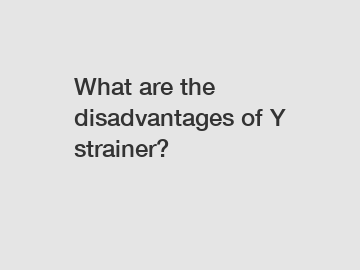What are the disadvantages of Y strainer?
Strainers play a critical role in ensuring the smooth operation of fluid systems by filtering out debris and unwanted particles. Among the various types available, Y strainers are widely used due to their simple design and ease of installation. However, like any other technology, Y strainers also have their limitations. In this article, we shed light on the disadvantages associated with Y strainers, giving you a comprehensive understanding of their potential drawbacks.
1. Limited Filtration Capacity.
One primary disadvantage of Y strainers lies in their limited filtration capacity. Due to their compact size and shape, Y strainers can only accommodate a specific volume of debris before clogging occurs. Consequently, their effectiveness diminishes over time, necessitating regular maintenance and cleaning. Failure to address this issue promptly may result in decreased flow rates, increased pressure drops, and potential damage to downstream components.

2. Increased Pressure Drop.
Another drawback of Y strainers is their tendency to create increased pressure drops within fluid systems. While designed to impose minimal resistance to flow, the presence of a strainer inherently opposes fluid movement. As debris accumulates within the Y strainer, the effective filtration area is reduced, causing higher pressure drops. This increased resistance can disrupt system performance and place additional strain on pumps, leading to decreased overall efficiency.
3. Regular Maintenance Requirements.
Proper maintenance is crucial for ensuring the optimal functioning of Y strainers. Due to their susceptibility to fouling, routine cleaning and inspection become necessary. The process of disassembling, cleaning, and reassembling the strainer can be time-consuming and labor-intensive. Additionally, if the cleaning process is not conducted correctly, there is a risk of damaging the strainer and its components, further complicating the maintenance procedure.
4. Limited Usage in High-Pressure Systems.
Y strainers are generally not recommended for use in high-pressure systems due to their design limitations. The stress exerted on the Y-shaped body under high-pressure conditions may lead to potential deformation, compromising the functionality and integrity of the strainer. In such cases, alternative strainer designs, specifically designed to handle high-pressure applications, should be considered.
5. Incomplete Filtration.
Although Y strainers are effective in capturing larger particles and debris, they may not be as efficient in filtering smaller particles. If the system requires the removal of fine contaminants, the Y strainer's mesh size may not be adequate. Contaminants that are smaller than the mesh openings can bypass the strainer, leading to potential damage to downstream equipment.
6. Susceptibility to Corrosion.
Depending on the fluid being filtered, Y strainers may be vulnerable to corrosion over time. If the fluid contains corrosive agents, continuous exposure can cause the strainer body and components to deteriorate. This corrosion undermines the structural integrity of the strainer and compromises its effectiveness, necessitating more frequent replacements or comprehensive protective measures.
Conclusion.
While Y strainers are widely utilized in various industrial applications for their simplicity and cost-effectiveness, it is important to acknowledge their limitations. From limited filtration capacity and increased pressure drops to regular maintenance requirements and limited usage in high-pressure systems, understanding these disadvantages empowers system operators to make informed decisions when selecting the appropriate strainer for their application.
To mitigate these shortcomings, alternative strainer designs such as basket or duplex strainers can be considered for specific applications. These variations offer enhanced filtration capabilities, reduced pressure drop, and improved ease of maintenance. Ultimately, a thorough understanding of the disadvantages of Y strainers enables professionals to implement the best solution for their fluid systems, ensuring smooth operations and prolonging the lifespan of downstream equipment.
If you want to learn more, please visit our website din f4 gate valve manufacturer, non rising stem knife gate valve, china casting valve manufacturers.
221
0
0

Comments
All Comments (0)